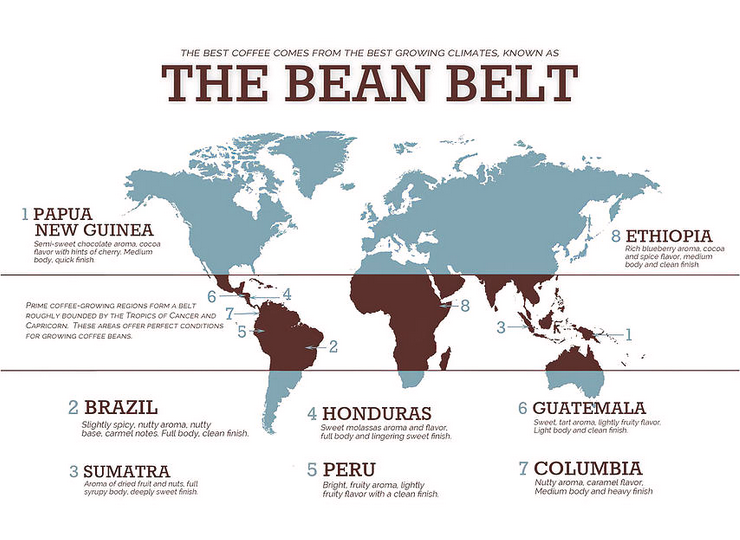Coffee adventures: the Bean Belt

The coffee bean belt, also known as the coffee belt or coffee growing region, is a geographic area located between the Tropics of Cancer and Capricorn where the conditions are ideal for coffee cultivation. This belt spans the globe, encircling it at the equator and creating a band that is roughly 23.5 degrees north and south of the equator.
The primary reason for the existence of the coffee belt is the climate it offers. Coffee plants thrive in tropical climates with consistent temperatures, abundant rainfall, and high humidity. The combination of these factors creates the perfect conditions for the growth of the coffee plant, Coffea, and the development of its cherries, which contain the sought-after coffee beans.
One of the key elements of the coffee belt is its consistent temperature range. Coffee plants generally require temperatures between 15-24 degrees Celsius to flourish.
The equatorial regions within the coffee belt provide this stable climate, allowing coffee plants to grow year-round without the stress of extreme temperature fluctuations. This is crucial for the delicate process of coffee bean development.
Rainfall is another critical factor in the coffee belt. Coffee plants need a consistent amount of rainfall throughout the year for optimal growth. The equatorial regions tend to have well-distributed rainfall, creating a suitable environment for coffee cultivation. However, variations in altitude and local topography within the coffee belt can influence the amount of rainfall a particular region receives.
Altitude plays a significant role in the quality and flavor profile of coffee beans. Many of the best coffee-producing regions are located at higher altitudes within the coffee belt. The cooler temperatures at higher elevations slow down the maturation process of the coffee cherries, allowing them to develop more complex flavors. This is why coffee connoisseurs often seek out beans from high-altitude regions within the coffee belt for a more refined and nuanced cup of coffee.
The coffee belt is home to some of the world's most renowned coffee-producing countries, including Ethiopia, Colombia, Brazil, Vietnam, and Costa Rica, among others. Each of these regions contributes unique characteristics to the coffee they produce, influenced by factors such as soil composition, altitude, and local farming practices.
While the coffee belt provides optimal conditions for coffee cultivation, it is not without its challenges. Climate change poses a threat to coffee production, as rising temperatures and shifting weather patterns can impact the traditional growing regions. Additionally, pests and diseases can pose risks to coffee crops, requiring careful management and sustainable farming practices to ensure the longevity of the coffee industry in these regions.
Understanding the unique attributes of the coffee belt helps to appreciate the complex journey from bean to cup and the rich diversity of flavors that coffee enthusiasts around the globe savor.

